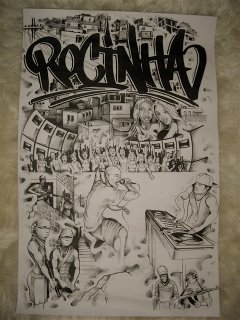Wayne asked if I could post a list of which Miami bass tracks caught the ears of the funk faithful down in Rio.
I picked up two CDs of Miami bass at the pirate stands of Uruguiana market. Unfortunately I don't have them physically with me, so I can't scan you the covers. But here's the track list of the first:
Miami Beat Vol. 11
1. The Beat Club - Security (Remix)
2. N2Deep - Toss Up
3. Toddy Tee - Just Say No
4. Svemtyle - Weekend Tool
5. Renard With No Regard - How Hard Can You Throw It?
6. Beat Master Clay D & The Get Funky Crew - Move Your Body to the Beat
This is one is incomplete because some of the tracks didn't rip to mp3 -- and without the CD, I can't recall what the other tracks were (nor does Google turn up anything for "Miami Beat Vol. 11" or similar searches).
Of the 6 tracks I do have, there are two odd ones out: N2Deep and Toddy Tee are both early 90s Southern California rap groups, examples of the sound that became popularized by the likes of 2Pac and Dre (cf "California Love", et al.). That's not terribly surprising given that this is theoretically volume 11 of a compilation series -- the roster gets a bit then by that point, I imagine. Doubly unsurprising given that Miami and California comprise two-thirds of most Brazilians impression of America. New York City is the other terra cognita, with Texas/Washington forming a bizarre twin identity in people's minds on account of Bush. I suspect that'll pass after '08, however.
What we're left with, meanwhile, are some decidedly Miami tracks, if not always identifiable ones.
The Beat Club have a verified Miami history, although the track in question,
"Security (Remix)", comes off the A-side from an eponymous 12" released in 1990 after they moved to the UK. That would help explain why this version sounds more like straight dance music (the Discogs' bio notes that they hooked up with New Order's manager upon arrival). This track also presents a good example of the Miami-Rio borrowing, live and direct:
First, note the keyboard stab at 1:13-1:16:
The Beat Club - Security (Remix)Compare to the opening of one of my favorite recent funk tracks:
Peko, Marcelinho, and MC Gil do Andaraí - Treme TerraMoving on, Renard With No Regard and Beat Master Clay D offer two fairly textbook examples of both strains in the Miami music scene of that era.
"How Hard Can You Throw It?" winds a single chorus and snappy drum machine hits & handclaps across a very skeletal structure -- just a pure, deep bass track -- while
"Move Your Body to the Beat" works the more lush sound of freestyle.
Unfortunately, I can't identify the last track. "Svemtyle" and "Weekend Toll" have both turned up nothing in my searches, nor have the scattered lyrics. Hear for yourself and let me know if it rings any bells, but it's definitely squarely in the bass tradition, feeding in trademark snippets of "Planet Rock" and "Whoomp There It Is"-style bass.
Svemtyle - Weekend TollThe identification issue is definitely a tough one. It took some digging to get tracks 5 & 6 named properly. From the CD I had them as the fairly incomprehensible "Ther - How Hard Can You" and "Tamber Raider - Crow Time", respectively. But a disregard for accurate attribution is nothing new, as the mess of my pirated funk CDs can easily attest to. It all reinforces an attitude pervasive in the funk scene that names and ownership of the recording are not as important as the live performance. Why, indeed, so many recordings I did get were simply from live performances.
Certainly a lot of this stems from simple economics. If you're among Rio's poor (as funk MCs often are), studio time is expensive. It's worth cutting a track semi-professionally so you have something to give DJs and are able to promote yourself among those who can pay you. Why bother recording for the purpose of a CD release when it's only going to be sold as a pirated copy?
And so, without the music-as-industry that we're used to in the States (take another look at
Wayne's article again -- I just finished it today and it resonates quite a bit, the general trends he discusses as present in Jamaica are surely universal for popular music in developping countries), the emphasis is less on the objective (recording) and more on the subjective (performance). Everything, it seems, is wrapped up in the performance.
Paul's thesis elaborates upon the socio-political aspects of the performance, my understanding of funk's economics all point to the performance as the main revenue source, and as a result (or because of?) all this, the music itself is generated more at the performance than anywhere else. That is to say, baile and funk are inseparable.
It's a double-edged sword, ultimately. The MC's life is not an easy one, as I witnessed. From the hustle of trying to get gigs, to the frenetic weekends of singing at multiple parties in the same night, to the impossibility of income from recordings, funk's flexibility is also its curse. From a theoretical standpoint, I think it's fascinating -- the openness, the fluidity, the subjectivity, the bricolage, the perfomativity -- but I can't forget the human element of it all. Paul ultimately demures from calling funk revolutionary, and looking at how it works in practice, I can only agree.
[booty bass rumblings into philosophical speculations part 2, coming soon. more tracks, better tagged, but also more predictable.]
Labels: americanization, funk, globalization, miamibass, rio












